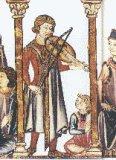JOURNOS V. SCIENTISTS
My Google Alert just alerted me to an article from the British Daily Mail, saying that the remains found in Leicester “DO belong to Richard III”. Please note, I am aware that the Daily Mail might not be the best source, when it comes to accuracy in historical research.
They quote a source with “knowledge of the excavation” revealing that not all evidence was published at press conference in September and that the remains were shown for certain to be those of Richard III.
I have no doubt that not all available information was divulged at that press conference, but the Daily Mail’s assertion that the scientists were holding the news back to achieve greater publicity, sounds to me like too much of a journalist’s approach. We all know that in the media industry it is vital to get the news out first, no matter whether they later on turn out to be inaccurate.
However, I would think that scientists first want to make absolutely sure that what they announce is actually true. This point was also made clear by a spokesman of the University of Leicester saying that “everything we were willing to reveal and that we were sure of, we revealed (in September).”
Maybe that just sums up the difference between some journalists and scientists.
There is quite a variety of indications that the Daily Mail’s assertion might very well turn out to be true, and I most certainly hope so, but in the end, I would prefer to have scientific evidence rather than the say-so of some unnamed source with “knowledge of the excavation”.
In response to the Daily Mail story The University of Leicester issued a statement denying that they withheld any additional evidence at the press conference in September. They stressed that the tests have not yet been completed, but so far they “are yet to find strong evidence to challenge our original hypothesis”. The results will be published early in the 2013.
They also added that they will not benefit financially from the Channel 4 production, as they value the “complete academic independence in [their] judgement.” Ricardians are often asked why we care about someone who has been dead for over 500 years. We care because we care about justice, which can only be based on independent research.
You can find original article here:
Anthony Bond, ‘Human remains found in Leicester car park DO belong to Richard III… but scientists are holding back findings until Channel Four documentary is aired, claims insider’, Mail Online (15 Dec 2012). URL: http://www.dailymail.co.uk/news/article-2248448/Human-remains-Leicester-car-park-DO-belong-Richard-III–scientists-holding-findings-Channel-Four-documentary-aired-claims-insider.html Date accessed: 15 Dec 2012
The response is here:
‘Search for King Richard III: Statement from the University of Leicester, 15 December 2012’, University of Leicester (15 Dec 2012). URL: http://www2.le.ac.uk/news/blog/2012/december/statement Date accessed: 16 Dec 2012
Tags: Archaeology, Leicester, Leicester Greyfriars Dig, Richard III




